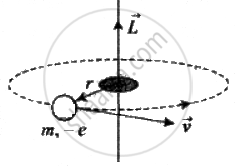Advertisements
Advertisements
Question
Taking the Bohr radius as a0 = 53 pm, the radius of Li++ ion in its ground state, on the basis of Bohr’s model, will be about ______.
Options
53 pm
27 pm
18 pm
13 pm
Solution
Taking the Bohr radius as a0 = 53 pm, the radius of Li++ ion in its ground state, on the basis of Bohr’s model, will be about 18 pm.
Explanation:
Bohr’s radius of orbit (for Hydrogen and H,-like atoms): For an electron around a stationary nucleus, the electrostatic force of attraction provides the necessary centripetal force.

i.e., `1/(4πε_0) ((Ze)e)/r^2 = (mv^2)/r` ......(i)
Also `mvr = (nh)/(2pi)` ......(ii)
From equations (i) and (ii), the radius of nth orbit
`r_n = (n^2h^2)/(4pi^2 kZme^2) = (n^2h^2ε_0)/(pimZe^2) = 0.53 n^2/Z Å` ......`(k = 1/(4πε_0))`
⇒ `r_n ∝ n^2/Z` or `r_n ∝ 1/Z`
`r_n = a_0 n^2/Z`, where a0 = the Bhor radius = 53 pm
‘The atomic number (Z) of lithium is 3.
As `r_n = a_0 n^2/Z`,
Therefore, the radius of Li++ ion in its ground state, on the basis of Bohr’s model. will be about `1/3` times to that of Bohr's radius.
Therefore, the radius of lithium ion is near r = `53/3` = 18 pm.
APPEARS IN
RELATED QUESTIONS
How many electrons in an atom may have the following quantum numbers?
n = 4, `m_s = -1/2`
Using Bohr’s postulates for hydrogen atom, show that the total energy (E) of the electron in the stationary states tan be expressed as the sum of kinetic energy (K) and potential energy (U), where K = −2U. Hence deduce the expression for the total energy in the nth energy level of hydrogen atom.
The numerical value of ionization energy in eV equals the ionization potential in volts. Does the equality hold if these quantities are measured in some other units?
Ratio of longest to shortest wavelength in Balmer series is ______.
The Bohr model for the spectra of a H-atom ______.
- will not be applicable to hydrogen in the molecular from.
- will not be applicable as it is for a He-atom.
- is valid only at room temperature.
- predicts continuous as well as discrete spectral lines.
The inverse square law in electrostatics is |F| = `e^2/((4πε_0).r^2)` for the force between an electron and a proton. The `(1/r)` dependence of |F| can be understood in quantum theory as being due to the fact that the ‘particle’ of light (photon) is massless. If photons had a mass mp, force would be modified to |F| = `e^2/((4πε_0)r^2) [1/r^2 + λ/r]`, exp (– λr) where λ = mpc/h and h = `h/(2π)`. Estimate the change in the ground state energy of a H-atom if mp were 10-6 times the mass of an electron.
The ground state energy of hydrogen atoms is -13.6 eV. The photon emitted during the transition of electron from n = 3 to n = 1 unknown work function. The photoelectrons are emitted from the material with a maximum kinetic energy of 9 eV. Calculate the threshold wavelength of the material used.
A 20% efficient bulb emits light of wavelength 4000 Å. If the power of the bulb is 1 W, the number of photons emitted per second is ______.
[Take, h = 6.6 × 10-34 J-s]
What is the energy of an electron in stationary state corresponding to n = 2?
An electron in a hydrogen atom has an energy of -3.4 eV. The difference between its kinetic and potential energy is ______.
